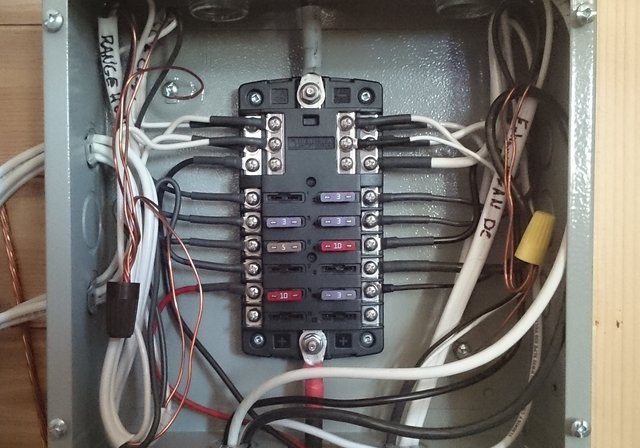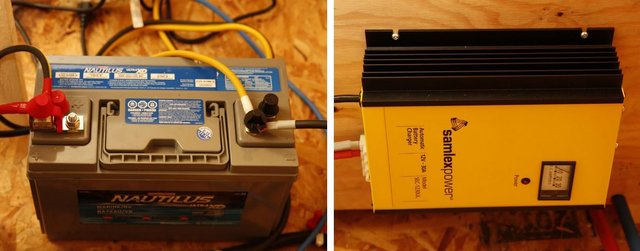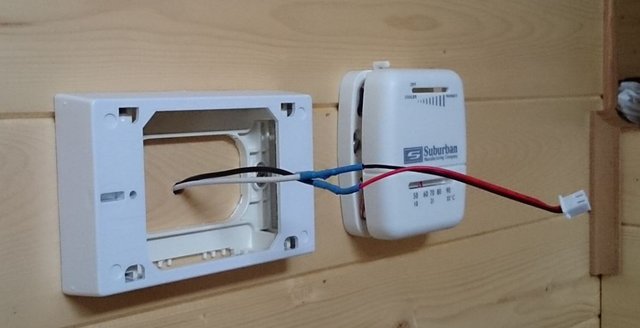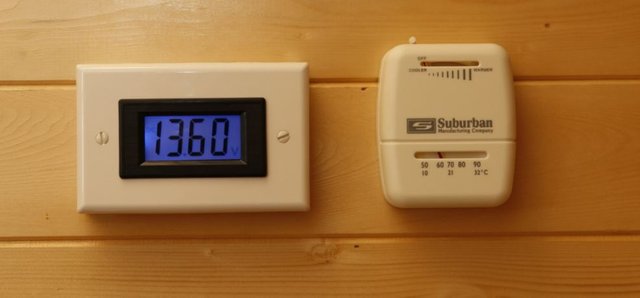Tiny House Episode 19: Off-Grid Electrical
 This is the bad ass fuse block that helps us regulate our DC system. I used 14/2 Romex wire for most of our circuits so black is positive and white is negative. Normally for DC systems, red is positive and black is negative. I used heat shrink to cover the crimp on the ring terminals.
This is the bad ass fuse block that helps us regulate our DC system. I used 14/2 Romex wire for most of our circuits so black is positive and white is negative. Normally for DC systems, red is positive and black is negative. I used heat shrink to cover the crimp on the ring terminals.You may recall, early on in the tiny house series that I discussed our Electrical System Rough In. We decided to install both an AC and a DC system into our tiny house to make it more off-grid capable.
Our AC system is very basic, just a small panel with one 15 amp circuit plus room for two more breakers, should we decide to add another circuit or two.
Our DC system is definitely more complicated but also a lot more fun to work on. In fact, I think the DC system was the most interesting project I did for the tiny house. Almost everything in the house runs on DC power with a couple of exceptions which meant lots of dedicated circuits and lots of different fuses.
Since we would be on the grid for awhile but may transition the tiny house off-grid in the future, I installed a single battery and a battery charger that runs on AC power. I chose this size of battery charger so that if we upgraded to 5-6 batteries at a later date it would be able to handle the increased load. Later on, if we are running on renewables, I can add a charge controller to prevent us from overcharging our batteries. Adding and inverter would also allow us to run the few AC appliances we do have.
 Close up of the battery and charger. If you look closely at the positive terminal on the battery you can see the inline 100 amp fuse.
Close up of the battery and charger. If you look closely at the positive terminal on the battery you can see the inline 100 amp fuse.Battery technology has come a long way in the last decade. Since we decided to start with just one battery we went with a premium AGM (Activated Glass Mat) battery which is a total beast. Even though it is a deep cycle battery, it claims to have over 2000 cold cranking amps! That's more than most flooded lead acid batteries that are made specifically for winter cold starts.
 I left room to upgrade the battery bank and add a charge controller and inverter.
I left room to upgrade the battery bank and add a charge controller and inverter.Just to give you an idea how efficient our DC system is and how little power we use, even with just the one battery we can go well over a day running our lighting, fans, furnace and water pump. Not only have we tested it extensively to see how long it would last, a few times the rural power went out and we didn't even notice! Even if the tiny house remains on-grid it is really nice to have back up power for emergencies.
The next thing I worked on was the fuse block. A fuse block is to DC electricity what a breaker panel is to AC. It basically disconnects the circuit if too much current goes through it. This prevents the wires from overheating and potentially starting fires if there is a short or you just demand too much from a given circuit.
I also wanted some way to keep track of how much power we had left in our bank. A voltage meter is not an accurate way to calculate the exact amount of power you have left but it can give you a good idea of where your battery(ies) are at.
 I purchased an inexpensive voltage meter from Amazon and installed it into this typical wall plate. I had to find a vinyl plate because the plastic ones tended to crack when I tried to enlarge the hole. The hole also needed to be very precise because the lip on the voltage meter was very small.
I purchased an inexpensive voltage meter from Amazon and installed it into this typical wall plate. I had to find a vinyl plate because the plastic ones tended to crack when I tried to enlarge the hole. The hole also needed to be very precise because the lip on the voltage meter was very small. The best place we could find to put the meter and thermostat was on the side of the closet but there was no where in the closet for a standard electrical box so I used an exterior mounted one.
The best place we could find to put the meter and thermostat was on the side of the closet but there was no where in the closet for a standard electrical box so I used an exterior mounted one. The finished product. Pretty slick, eh?
The finished product. Pretty slick, eh?In our case our, single AGM battery is fully charged when the charger is off and it is reading between 13 and 13.1 volts. We try not to let it drop below 12.4 volts so we don't discharge the battery too much which would shorten it's lifespan.
Maybe a discussion of different types of batteries for off-grid systems would interest you? If so, let me know in the comments below. Also, stay tuned for the video adjunct to this article because both the video and accompanying article will contain some additional information I didn't cover here.
That looks amazing. I can't wait to try solar. Your volt meter does look very slick.
Thanks, I can't wait to try it out either!
Thanks for posting that. I love to see how other folks understand their systems and install them.
The dirst thing I went for after the batteries was an inverter. I got a cheap one from eBay to experiment with, as the Aussie prices for good units are prohibitive. I got a 2000W (peak 4000W) unit for $60AUD and it hasnt failed yet.
I'm looking forward to anything else you may post on the topic.
There will be a bit more on 12v DC power for sure.
Pretty slick indeed :)
Excellent working! Election tips
Thank You!